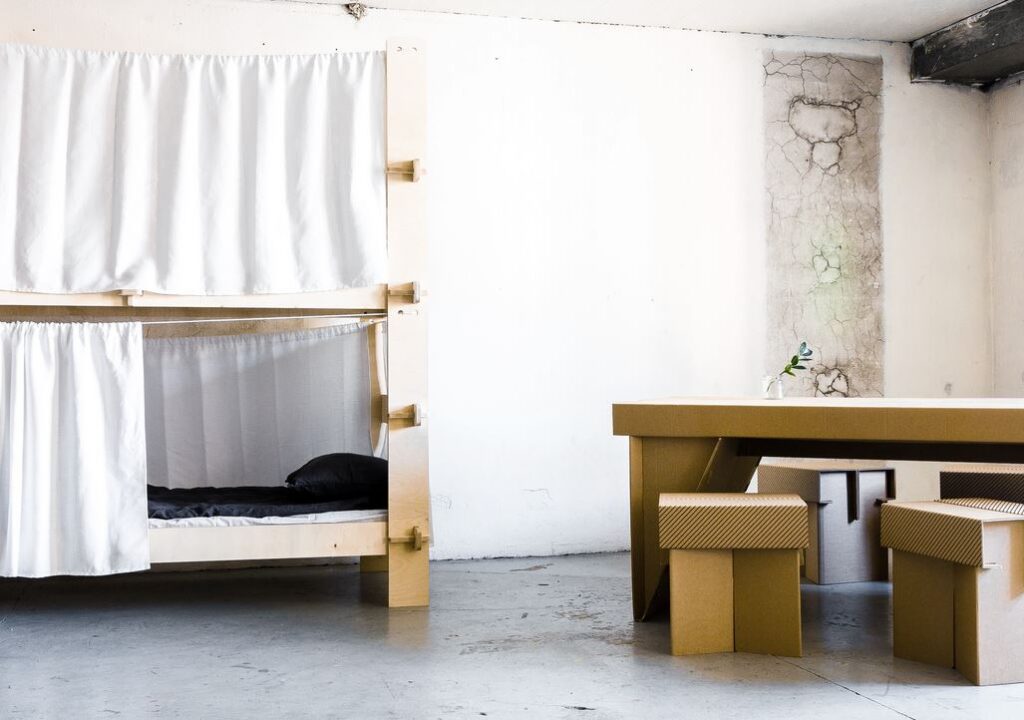
This paper concerns proposing selection of segmentation tools and distribution channels for Rehome products. This paper concentrates on the possibilities the temporary housing offers Rehome as a second main segment in addition to the humanitarian accommodation (B-to-B), which is mainly applied in crisis situations.
Authors: Prashant Shrestha and Tiina Pernanen
About Rehome
Rehome is an EU funded project based in LAB University of Applied Sciences. It aims to promote bio-based industry in Lahti region, its commercialization, employment and export. The main goal is to develop a rapid production of inexpensive furniture in high volume to meet the criteria of the primary need in humanitarian and temporary housing. The product range includes 4 different beds, a dining set, space dividers, a shelf and private space. The project ended in April 2021. (Rehome 2020.)
During past two years tens of IBU-students contributed to wide data collection from different linguistic regions. They analyzed potential B-to-B customers from humanitarian perspective and B-to-C segments from temporary housing perspective. The project gained a deeper understanding about the possibilities based on information delivered by students in Internationalization Process course.
Market segmentation is essential for success
Nowadays, there are many potential profitable markets due to mass production, mass communication, increasingly advanced technology, and effective global transportation (Brassington & Pettitt 2013, 132). These markets have numerous buyers with different needs and buying habits. Due to the limited resources, the company cannot serve the whole market. (Zimmerman & Blythe 2013,120.) Market segmentation also works as the base for creating effective strategies for consumer relationship management and distribution channels (Weinstein 2004). Moreover, market segmentation also helps the company with a competitive advantage over the other companies by helping them to define their unique value proposition (Armstrong & Kotler 2013, 192). So, market segmentation is an important tool for small companies and projects like Rehome to create a homogenous group of consumers and target the most lucrative consumer segment.
Market segmentation is a multi-stage process. Firstly, the marketer must identify the market to study. After this, the marketer must set some base variables for segmenting the consumer. The base variables can be categorized into four types: geographical, demographic, psychological and behavioral variables. The geographical variable includes characteristics like location, language, city, country, etc. The demographic variable includes characteristics like age, gender, relationship status, family size, etc. Moreover, the psychological variable includes preferences, opinions, etc. Behavioral variables include reaction and response toward the product. (Armstrong & Kotler 2013, 193.) The next stage is to identify and name the consumer segments. Finally, the marketer must select effective segments based on the evaluation of the company’s objective, structural attractiveness and growth opportunities. (Armstrong & Kotler 2013, 203.)
Distribution channels
Distribution channels are a set of interdependent organizations involved in the process of making the product or service available for use of consumption. The decision of the distribution channel is one of the crucial decisions made by the management. The chosen marketing channel affects all the marketing decisions in the organization. (Kotler & Keller 2009, 450.) Marketers can either choose intermediaries to transfer the product to the final consumers (indirect distribution channels) or they can transfer the product themselves (direct distribution channels). Direct distribution is a quite simple and low-cost channel. Use of both channels is known as hybrid distribution channels (Sakshi 2020).
Key Findings
Potential segments and distribution channels were studied in spring 2020 (Shrestha 2020). The primary data was collected via a survey from various random respondents. It was distributed through Facebook, Email, Yammer and LinkedIn. There were 90 respondents from nine different countries.
According to the findings, the main segments can be listed as follows:
- respondents living in Asia
- males more likely to buy products than females
- respondents under 30 years
- single people living alone with no children
- respondents moving a lot
- respondents less concerned about durability and more concerned about price and environment
Analyzing the consumer segments the major potential consumer segment could be an Asian male under 30, moving a lot and with small family size and being a person preferring price and environment over durability.
Furthermore, these segments have different needs and hence choose the different products according to their need. For instance, the bunk bed was popular among the male respondents living in Asia, and respondents with children. Moreover, the dining set and the baby cot were popular among the female respondents. However, the single bed and shelf were the most popular products among the consumers.
Furniture store vs. Online store
The most popular distribution channels were furniture and online stores. Moreover, the furniture store was more preferred in Asia and the online store in Europe. Rehome can either use the hybrid distribution channel with a combination of a furniture store and an online store or it can use indirect distribution channels with few intermediaries i.e. furniture stores.
It seems the Asian furniture market differs from the European market as the furniture stores in Asia are very small. They can be found all over the city area, more or less in every quarter. Contrary to Asia, the huge furniture stores in Europe are often located in the outskirts of the cities and are for younger generation harder to access. It would be desirable to study whether Rehome products could fit into the hypermarket sector in order to be easily accessed by a extensive customer segment.
The products can be stored easily and produced rapidly in demand. Analyzing the nature of the product, online stores seem to be a more attractive option. However, this would maybe give a reason for further product development in order to optimize the parcel sizes which affect the postage and hence the final price for the consumer.
The Future of Rehome
The Rehome project has been very inspiring and productive. The first drafts were made in 2016. Senior Lecturer Mr Vesa Damski has continued skizzing new products to the product range with his design students. The big picture around the climate change has led to new innovations as Rehome toilet. There are still many more ideas to come.
References
Armstrong, G. & Kotler, P. 2013. Marketing: An Introduction. The 11th revised edition. United States: Pearson Education Limited. [Cited 27.5.2021]. Available at: https://lut.primo.exlibrisgroup.com/permalink/358FIN_LUT/17jm55t/alma991344325406254
Brassington, F. & Pettitt, S. 2013.Essentials of Marketing. The 3rd revised edition. Harlow: Pearson. [Cited 27.5.2021]. Available at: https://lut.primo.exlibrisgroup.com/permalink/358FIN_LUT/17jm55t/alma991340055406254
Kotler, P. & Keller, K. 2009. Marketing Management. 13th Edition. London: Pearson Education Limited. [Cited 27.5.2021]. Available at: https://lut.primo.exlibrisgroup.com/permalink/358FIN_LUT/17jm55t/alma99779945406254
Rehome. 2020. Rehom. [Cited 27.5.2021]. Available at: http://www.rehomefurniture.com
Sakshi, A. 2020. Types of Distribution Channels. [Cited 27.5.2021]. Available at: http://www.economicsdiscussion.net/distribution-channel/types-of-distribution-channels/31760
Shrestha, P. 2020. Consumer segmentation and product distribution channels: Case: Rehome. [Cited 27.5.2021]. Available at: http://urn.fi/URN:NBN:fi:amk-2020052814958
Weinstein, A. 2004. Handbook of Market Segmentation: Strategic Targeting for Business and Technology Firms. 3rd ed. Routledge: ProQuest Ebook Central. [Cited 27.5.2021]. Available at: https://lut.primo.exlibrisgroup.com/permalink/358FIN_LUT/1ricsah/alma991933112606254
Zimmerman, A. & Blythe, J. 2013. Business To Business Marketing Management. The 2nd revised edition. Great Britain: TJ International Ltd. [Cited 27.5.2021]. Available at: https://lut.primo.exlibrisgroup.com/permalink/358FIN_LUT/17jm55t/alma991343805406254
Authors
Prashant Shrestha is a graduated International Business Student at LAB University of Applied Sciences.
Tiina Pernanen is a Senior Lecturer at Lahti University of Applied Sciences.
Illustration: Bunk bed by Henri Mertanen. Photo: Antti Turunen. Available at: http://www.rehomefurniture.com/
Published 28.5.2021
Reference to this article
Shrestha, P. & Pernanen, T. Rehome temporary living in B-to-C segment. LAB Pro. [Cited and date of citation]. Available at: https://www.labopen.fi/lab-pro/rehome-temporary-living-in-b-to-c-segment/






